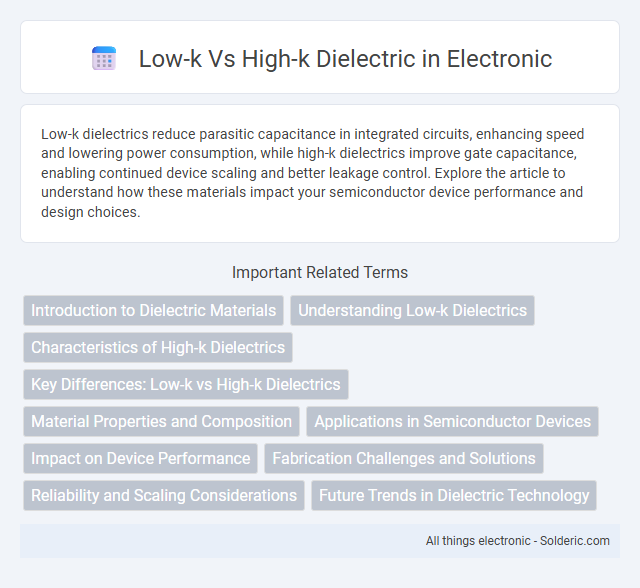Low-k dielectrics reduce parasitic capacitance in integrated circuits, enhancing speed and lowering power consumption, while high-k dielectrics improve gate capacitance, enabling continued device scaling and better leakage control. Explore the article to understand how these materials impact your semiconductor device performance and design choices.
Comparison Table
| Feature | Low-k Dielectric | High-k Dielectric |
|---|---|---|
| Dielectric Constant (k) | Typically below 3.9 | Above 7, often between 10 to 25 |
| Purpose | Reduces parasitic capacitance in interconnects | Increases capacitance in transistor gate dielectrics |
| Applications | Inter-layer dielectrics in ICs | Gate oxides in MOSFETs, DRAM capacitors |
| Material Examples | Silicon dioxide (SiO2), organosilicates | Hafnium oxide (HfO2), zirconium oxide (ZrO2) |
| Impact on Device Performance | Minimizes signal delay, crosstalk | Enhances transistor scaling, reduces leakage |
| Integration Challenges | Mechanical fragility, integration complexity | Interface states, mobility degradation |
Introduction to Dielectric Materials
Dielectric materials are essential in semiconductor devices as they influence capacitance and insulation properties critical for performance and scaling. Low-k dielectrics reduce parasitic capacitance, enhancing speed and reducing power consumption in integrated circuits, while high-k dielectrics allow for increased capacitance without thinning the insulating layer, improving transistor control. Understanding the trade-offs between low-k and high-k materials helps optimize your device's electrical efficiency and reliability.
Understanding Low-k Dielectrics
Low-k dielectrics are materials with a low dielectric constant, typically less than 3.0, designed to reduce parasitic capacitance in semiconductor devices and improve signal speed and power efficiency. Understanding low-k dielectrics helps you optimize integrated circuit performance by minimizing signal delay and crosstalk in advanced microelectronics.
Characteristics of High-k Dielectrics
High-k dielectrics exhibit a high dielectric constant, typically greater than 10, which allows for increased capacitance without reducing the physical thickness of the insulating layer. These materials, such as hafnium oxide (HfO2) and zirconium oxide (ZrO2), enable better scaling in advanced semiconductor devices by minimizing gate leakage current and improving thermal stability. High-k dielectrics also offer enhanced compatibility with silicon substrates and maintain robust electrical reliability under high-field conditions.
Key Differences: Low-k vs High-k Dielectrics
Low-k dielectrics have a dielectric constant typically below 4, reducing capacitive coupling and improving signal speed in integrated circuits, while high-k dielectrics exhibit dielectric constants greater than 10, enabling better gate capacitance control and scaling in advanced transistors. Low-k materials are commonly used in interconnect layers to minimize RC delay and power consumption, whereas high-k materials such as hafnium oxide are essential in gate oxides to prevent leakage currents and enhance transistor performance. The primary difference lies in their applications: low-k dielectrics optimize interconnect performance, while high-k dielectrics enable continued device miniaturization and scaling in semiconductor fabrication.
Material Properties and Composition
Low-k dielectrics typically feature silicon dioxide or organic polymers with dielectric constants below 3.9, reducing capacitance and improving signal speed in microelectronics. High-k dielectrics, such as hafnium oxide or zirconium oxide with dielectric constants above 10, offer better capacitance scaling for advanced transistors but present challenges in integration and leakage current. Your choice between low-k and high-k materials depends on balancing insulating properties and device performance requirements.
Applications in Semiconductor Devices
Low-k dielectrics, characterized by their low dielectric constant (k < 3), are essential in minimizing capacitive coupling in advanced semiconductor devices, thereby enhancing signal speed and reducing power consumption in interconnects of integrated circuits. High-k dielectrics, with a high dielectric constant (k > 10), are primarily used as gate insulators in metal-oxide-semiconductor field-effect transistors (MOSFETs) to improve gate control and reduce leakage currents, enabling further device scaling. The strategic choice between low-k and high-k materials directly impacts device performance, scaling, and energy efficiency in modern semiconductor manufacturing.
Impact on Device Performance
Low-k dielectrics reduce parasitic capacitance in semiconductor devices, enhancing speed and lowering power consumption, which is critical for high-performance integrated circuits. High-k dielectrics enable further device scaling by offering higher capacitance without increasing leakage current, improving gate control and transistor reliability. Balancing your choice between low-k and high-k materials directly impacts device performance, influencing speed, power efficiency, and scaling capabilities.
Fabrication Challenges and Solutions
Low-k dielectrics face fabrication challenges such as film porosity and mechanical fragility, requiring advanced deposition techniques like plasma-enhanced chemical vapor deposition (PECVD) to improve uniformity and reduce defects. High-k dielectrics confront issues including interface trap states and thermal stability, addressed by incorporating interface engineering methods such as atomic layer deposition (ALD) and annealing processes to enhance dielectric constant and reliability. Both materials demand precise control of thin-film thickness and contamination to optimize electrical performance in semiconductor devices.
Reliability and Scaling Considerations
Low-k dielectrics improve scaling by reducing capacitive coupling and power consumption in advanced semiconductor devices but often face reliability challenges such as increased susceptibility to moisture uptake and mechanical degradation. High-k dielectrics enable continued device scaling by providing higher capacitance without decreasing physical thickness, enhancing gate control and reducing leakage currents, yet can suffer from issues like mobility degradation and interface trap generation. Balancing reliability and scaling requirements involves optimizing dielectric materials for mechanical stability, electrical performance, and compatibility with existing fabrication processes in nanoscale transistors.
Future Trends in Dielectric Technology
Emerging research in dielectric technology highlights a shift towards ultra-low-k materials to enhance semiconductor performance by minimizing parasitic capacitance and power consumption in integrated circuits. High-k dielectrics continue to evolve with innovations in materials like hafnium oxide alloys, which improve gate leakage control and reliability for advanced transistor nodes. Future trends emphasize hybrid dielectric stacks and atomic layer deposition techniques to achieve optimal electrical properties and thermal stability in next-generation microelectronics.
Low-k vs High-k Dielectric Infographic

 solderic.com
solderic.com